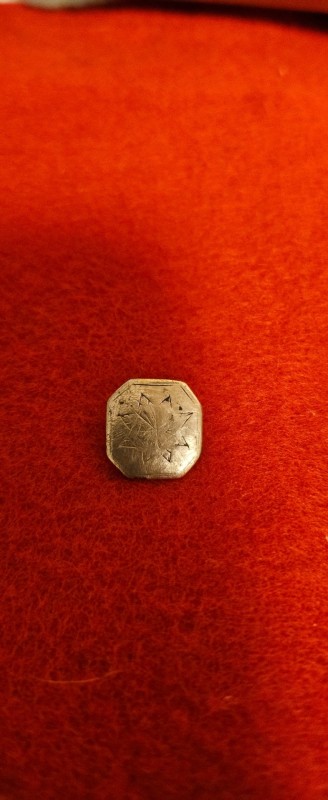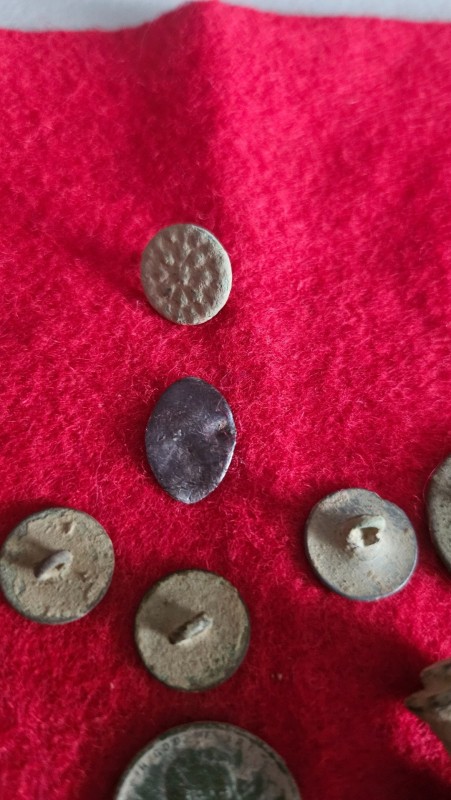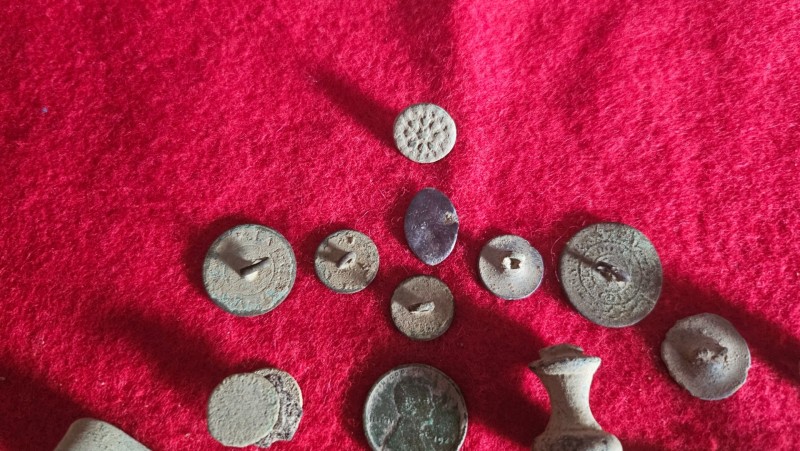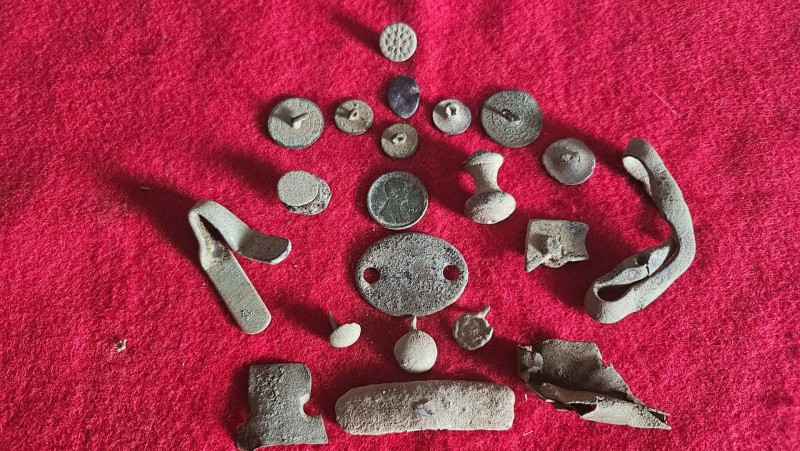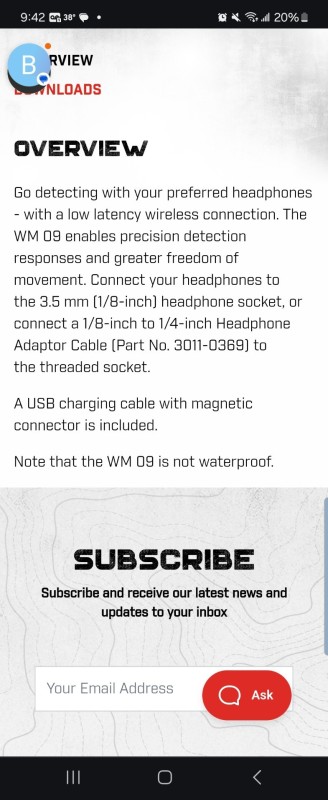-
Posts
6,096 -
Joined
-
Last visited
-
Days Won
32
Content Type
Forums
Detector Prospector Home
Detector Database
Downloads
Everything posted by Chase Goldman
-
While I like some of DD's products (the XP compatible headphones he sells are great as well as some of the other 3D printed accessories) there are two issues in play here. First, the XP design of the mount is fundamentally flawed because the objective to provide a mount that enables quick attachment and removal of the remote also results in high stress concentrations that cause the mount to gradually lose its ability to maintain a secure grip on the remote and eventually results in mount failure regardless of the material used (but some 3D printed materials are especially ill suited for this application - see Brad's pic). Second, applying bandaids such as locking levers, lanyards etc. to address the degrading secure grip issues don't really reduce the cyclic stresses (from constantly mounting and removing the remote for charging/storage etc.) that eventually causes failure (though some of these bandaids may reduce the number of "unnecessary" re-mounts resulting from the remote simply falling off the mount after being bumped while detecting). The real solution is to move completely away from the design altogether, and that's what the RC Digs cage accomplishes for a cost not much higher than purchasing a replacement XP or third party version of the original design (and certainly lower than multiple XP mount replacements over the lifetime of the rig). I like the RC Digs design, but have yet to put it through its paces. You lose the quick removal capability, but taking an extra 30 seconds to undo two thumbscrews for mount security and longevity is a small price to pay.
-

Is It Just My Impression? Coil Impact
Chase Goldman replied to raziel900's topic in XP Deus II Forum
Good question but for me it happens to me in Relic mode which does not have the ground stabilizer setting and in other modes with stabilizer set at 2. My hunting partner @F350Platinum has experienced increased coil bump sensitivity as well with V2.0 and he never runs Ground Stabilizer 1 because of the additional noise it introduces independent of coil bump sensitivity. Bottom line, most of the people I personally know who are experiencing coil bump sensitivity in V2.0 with the GS set at 2, not because they have it set at 1. But if I was having coil bump sensitivity issues, I agree that running GS at 1 is probably not a good idea. -
It started out looking more like an epic slog for me (but that was the expectation we set for ourselves since we were hitting the fringe areas). Reviewing the track, I didn't find my first keeper, a ragged flat button until 2.5 hours into the 5 hour hunt, then the floodgates opened and it was literally off to the races for us. Maintaining a positive attitude and trusting the plan paid off. Good times. Thanks for the meetup, my friend. Now we know where all those buttons we knew were there somewhere, were hiding. Can't wait for the next adventure.
-
After wrapping up my last 3 Virginia relic hunts of 2023 with a Colonial silver cufflink, a 1944 Merc and a 1793 2-Reale was hoping to keep my silver streak alive in my first hunt of 2024. Met up with Bob again to pillage Virginia beanfields and kept that silver streak alive with my second keeper of the day, another silver cufflink. This one is a little less fancy and tarnished, and not a Cob (congrats Bob), but silver is silver and I'll take it. In addition, snagged A LOT of small Colonial flat buttons, some with backmarks and one with a flower pattern. One shank still had some thread material still attached! A brass plate of some sort but with no markings, a collar stud, brass drawer pull, a couple plow mangled buckles and other miscellaneous brass, saddle studs (one with a fancy design), a lead ingot, '27 Wheatie.. All in all, a great start to 2024.
- 9 replies
-
- 20
-

-

-

Is It Just My Impression? Coil Impact
Chase Goldman replied to raziel900's topic in XP Deus II Forum
Well you’ve asked that question 3 times now in the thread, so apparently no one precisely knows the answer because it’s one of those “it depends” situations due to the number of variables involved. I don’t know the EXACT performance decrement in 3 either, I just know there would be some decrement as it is just another ground filter. Always keep mine at 2 if I’m using a mode that supports it at all - note that I mainly hunt in relic mode which does not have that setting in the GB menu. If I am in mild ground, I usually don’t even bother ground balancing/ground grabbing in relic mode. I notice that when I do a ground grab and the ground phase setting adjusts down from the default to match measured ground phase there is a slight increase in coil bump sensitivity and I have not really noticed a performance decrement in practice (note this is the opposite of what @Jeff McClendonobserved but he is adjusting GB from the default to actual in mineralized ground in his case vs. mild ground in my case, so I believe that is the reason for the different coil bump sensitivity with GB adjustment observations - but TBH I really don’t sweat it even when dealing with crop stubble because I can hear actual targets plainly by doing a re-swing, so I haven’t done any deep dive testing to fully characterize it). For that reason, unless I am getting A LOT of ground feedback, I just leave GB at the default setting…in relic mode. Why don’t you just run a simple a/b test: Place a test target in the ground near the typical or desired limit of detection depth in your soil with the detector Ground Balanced at stabilizer 2 and simply switch it to 3 to see how much the signal degrades, if at all. -
To answer your question more directly, the Deus 2 has a Magnetic ground accept/reject toggle setting in the ground balance menu of the beach modes only but @midalake, if I recall correctly, finds it to not be very useful and it ends up, for him, severely limiting depth performance in reject mode. I know that was the case pre-Version 2.0 Deus 2, not sure if he has fiddled with that setting since loading V2.0. He’ll probably chime in to clarify that.
-
What adjustments, if any, have you made from the default settings for audio (PCM, Square, High Square), the Audio Filter, tones (full, multi (2 through 5 tones), pitch , and salt sensitivity? You run Nox in horseshoe mode, do you run D2 in 0 Disc, negative disc? If D2 had a gold field/relic mode with salt handling it could possibly be better with black sand. I find relic to be the best mode for hot dirt, but it has no salt handling capability. I think Nox ground tracking is superior than D2 for rapidly shifting salt concentrations in surf/wash.Wash. I haven't played with the magnetic reject ground setting since ver 2.0 was issued, but it doesn't seem to do anything but limit non-ferrous depth with or without black sand present.
-
Agree. Conversely, in neutral soils (no salt, no mineralization), top end PI's have minimal depth advantage over top end VLFs like the Manticore or Deus 2 on coin or ring sized targets. So the OP's results are not surprising at all and wouldn't be surprising for many high end vlfs (i.e., the Manticore is not unique in this regard).
-

Looks Like M8's And M15's Are Starting To Appear
Chase Goldman replied to phrunt's topic in Minelab Manticore Forum
They should sell like hot cakes now. Good move Minelab! Marketing geniuses! -

Wm 09 Wireless Audio Module For Manticore
Chase Goldman replied to abenson's topic in Minelab Manticore Forum
The hard copy documentation actually included in the WM 09 package appears to be updated from the above and makes no mention of the WM 09 module being waterproof. That highlighted bullet text above does not exist. Based on that, the statement on the web page, and the fact that the WM 08 is also not waterproof, I conclude the WM 09 neither waterproof or weatherproof. -
I think he was specifically talking about the fact that this setup allows you to zip tie the WS6 holder to the mount. Although the mount will accommodate a remote, there is no obvious way to zip tie the remote to this (or any other) mount unless someone came up with a moulded mount that enclosed the remote like the WS6 holder does. Hmm...that would be a great idea.
-

What Can The Impulse AQ Do?
Chase Goldman replied to EL NINO77's topic in First Texas - Bounty Hunter, Fisher & Teknetics
Not sure what you meant by "interested to see what garrett does with this". They've already answered that with the Axiom...unless you meant to type "Fisher". Impulse AQ is a beach/water machine only. Because it is designed with salt cancellation, you can't balance it on land in its present form you and therefore can't use it for land-based nugget hunting. Fisher hinted at making a Gold hunting land variant but it appears the whole effort has just died. The last gasp was them trying to sell off whatever inventory they had of the pre-production special edition Impulse AQ units they still had lying around. Joe OBN above was doing a lot of the work for them addressing shortcomings in their battery design and battery mount design with his own hacks. As you can tell, he loves the pure raw power and performance of the machine but they have gone radio silent on it. I wouldn't hold your breath waiting for anything else to come of this. -
Welcome to the forum Newbe. Your best bet is to post this question in the Garrett Metal Detectors subforum on this site. In that subforum, detectorists who use Garrett detectors, and specifically the Apex, will be able to answer your questions specific to that detector. But before you post this question over there, it would be helpful to include some additional information with your new post such as the region of the US you are located and approximately where you plan to look for gold and whether you are simply looking for gold jewelry in a park or on a beach or natural gold in the ground as the best settings and mode will be dependent on which of those scenarios apply to you. Furthermore, experienced detectorists will be able to better weigh in on whether there is natural gold to be found in your area with your type of detector. Natural gold is not something that is found just anywhere and certain ground conditions and places that have been hit hard by detectorists looking for gold may mean that your detector, which is a good general purpose detector that can find gold but is not optimized for gold detecting and may be limited in its ability to detect gold in difficult conditions even if it is set up optimally to find it. Reality Check: Natural gold is a difficult target to detect in the ground because it is typically comprised of very small fragments that are hard to differentiate from other non-desirable targets such as iron bits, lead, and tiny pieces of brass or aluminum. It takes A LOT of patience and is best pursued after you have had some time to practice and getting used to how your machine responds to more commonplace targets such as coins, larger jewelry (rings, earrings, necklaces, etc), buttons, etc. Detecting for even these more commonplace but desirable items is also not necessarily straightforward or easy, especially if you are dealing with a lot of iron, aluminum, or other junk targets such as nails, cans and pieces of cans (such as ring pulls), fired bullets and brass casings or shotgun shells, fishing tackle, aluminum siding pieces, etc. There are ways to set up your detector to filter out some of these items, but not all and you also run the risk of filtering out a desirable target if you are not familiar with your detector's settings. My suggestion is that you read through your detector's manual - the electronic version can be downloaded here. Get some test targets like coins of various different denominations, jewelry, nails, pull tabs, aluminum cans, fishing sinkers, etc. and see how your detector responds to those targets in the various different modes by simply placing your test targets on the "clean" ground (ground that does not make noises when you pass over it after ground balancing - (see below)). The modes and the optimal targets those modes are designed for are described in the manual (hint: gold is probably best detected in zero or jewelry mode or in single frequency set to 20 khz). Just use the default settings for each mode, don't adjust anything, ground balance the detector per the instruction manual to cancel out the ground effects, and swing away at your test targets noting the audio and numerical response of the detector to each target. After you get used to your detector's response to surface targets, then detect your yard to see if you can find anything in it, then branch out to other areas such as a local park, ball field, or beach provided your local laws permit you to do so or ask a neighbor if you can detect their property, and get some addition experience with your detector. If you have not done so, obtaining some additional equipment is recommended. A hand digger, such as a garden trowel, screwdriver, or dedicated metal detecting hand digger can help with target recovery from the ground and there are ways you can recover the target without damaging yard turf. In less manicured areas, you might be able to use a shovel. If you are in a public area, there may be rules on what kind of digging implements are permitted to be used if metal detecting is allowed theres. A small handheld detector called a pinpointer also comes in handy for locating the target in dirt or in the hole that you have dug - items buried in the dirt can be deeper than expected, off center from the hole you dug, and are also not easily visible in the dirt if they have been buried for more than a few days. The pinpointer sounds off loudest when its tip nearest the target to help you find it quicker. Finally, it is handing to have some sort of pouch to hold your trash and treasure - it can be as simple as a tool apron or you can spend bucks on a dedicated metal detecting pouch where you can store finds, trash, your hand digger, and your pinpointer and anything else you carry along. There are no dumb questions. You are embarking on a new hobby and there is no way for you to know everything when first starting out. Welcome to the hobby, Good luck and Happy Hunting.
-

Going From .71 To 2.0 Update. Salt Beach With Black Sand.
Chase Goldman replied to midalake's topic in XP Deus II Forum
Dave, thanks for doing this comparison. Just a suggestion for the permanent record down the road (before you can no longer edit your original post), you might want to clarify in your original post which version was better for context. Your subject line is ambiguous and you never explicitly mention whether 2.0 or 0.71 is better in your post, just that you were impressed with the difference between them. I know most experienced users recognize you are probably talking 2.0 as being better but it is only implied not stated. A number of recent detector “updates” from various vendors have broken things that worked in prior versions, XP is not immune to this, so I never just presume the update is better. One way to misinterpret your post is that you were running 2.0 and reverted to 0.71 and felt it was better because some are testing 0.71 vs. 2.0 that way. TBH I wasn’t 100% sure myself by the way it was written. I only know that you mentioned in another thread you were running 0.71 for a week to get acclimated with it and switching to 2.0 so you could readily interpret the differences, but others who may have not seen that separate thread post wouldn’t know your methodology. -

Wm 09 Wireless Audio Module For Manticore
Chase Goldman replied to abenson's topic in Minelab Manticore Forum
Sorry, they didn't last. I'm sure more will be in stock soon. I agree that $139 price makes a lot more sense than $239. Not a bargain, but at least it's less expensive than the compatible wireless phones. -

Wm 09 Wireless Audio Module For Manticore
Chase Goldman replied to abenson's topic in Minelab Manticore Forum
Well there seems to be conflicting information from Minelab regarding whether the WM 09 is waterproof. From: https://www.minelab.com/accessories/wm-09-wireless-audio-module -

Wm 09 Wireless Audio Module For Manticore
Chase Goldman replied to abenson's topic in Minelab Manticore Forum
Thanks, Andrew. I could not find it on their site until I changed WM09 to WM 09. They are still in stock. -

Wm 09 Wireless Audio Module For Manticore
Chase Goldman replied to abenson's topic in Minelab Manticore Forum
It's an assumption, Chuck, but is based on the verified fact that ML is using the Nordic Bluetooth LE chipset and BT 5.2 compatible radios in their FCC filings and the headphone user manuals. We know they aren't using any flavor of APTX, because if they were, licensing would require them to reveal the APTX trademark. It could be FastStream which has similar latency to APTX-LL but with lower audio fidelity. The LC3 codec is the only BT codec that has superior low latency 20-30ms) to APTX-LL (30-40ms) or FastStream. Unlikely they are proprietary codec/platform such as that used in Minelab's separate low latency Wi-Stream radios as only the BT LE radio transmitter is mentioned in Manticore, Nox 700/900, and Xterra Pro specs and FCC filings and a separate Wi-Stream transmitter was used on tge Nox 600/800. I don't have an actual latency number but based on the above, it's at least as good as or likely better than APTX-LL (i.e., LC3). That's the basis for my statement in the previous post (p.s., I hedged and modified my previous post to add the word "likely" since we have no published latency spec numbers on the latest ML detector wireless audio, thanks for keeping me honest, Chuck). -

Wm 09 Wireless Audio Module For Manticore
Chase Goldman replied to abenson's topic in Minelab Manticore Forum
Well, I did mention that as an option in what you quoted but "better" than what option and in what respect: price, performance? They're certainly the least expensive option. And while latency is not the issue, plug-in transmitters have some minor drawbacks I discuss further below. The options above aren't listed in order of any preference, btw, because it's really something everyone has to figure out for themselves. Ideally, it would be nice not to have to add additional wireless transmitter claptrap to a detector that already has a low latency wireless transmitter installed that has less latency than BT APTX-LL by spec. But ML locked it down to only be compatible with their overpriced accessories and while the supplied headphones work fine for the most part, some have complained about their audio frequency response and wind noise, while others complain about lack of situational awareness while wearing them. They are also NOT waterproof or even weatherproof. So here we are. ML offers up the expensive WM09. BTW I personally have no issues with using either self-contained wireless phones or plugging into a wireless receiver that I can simply tuck away. As long as I'm untethered from the detector, I'm happy. One benefit with the tuck away receiver is that you can conceal it from the elements and protect it from weather. If your wireless phones are not weatherproof (most aren't) you may be out of luck unless you are wearing a rain hood. Regarding APTX-LL transmitters plugged into the headphone jack on the detector, as I said, latency is not the issue but there are minor drawbacks. Unless you have small, rigid transmitter with an integrated plug, you have to figure out how mount it without having it flop around, it's another thing you have to charge, and, finally, I have not seen any weatherproof transmitters so if you get caught in the rain you may be out of luck or have to improvise a way to keep it from getting wet. Like I said, these are all minor things but wort mentioning when considering different wireless options. -

Wm 09 Wireless Audio Module For Manticore
Chase Goldman replied to abenson's topic in Minelab Manticore Forum
Yep. We've just been waiting for them to release the inevitable ridiculous price point. Thanks for reminding me about it, Andrew. Doing some web diving I found this: From this website it looks like $229US MAP. Ugh. I've also seen $249AUS. Won't know for sure until more dealers start to advertise for pre-orders and no release date so far. If that's a real MAP, not surprised based off the WM08 price, but it's $200 more than it should be. At that price, if I needed an alternative to the ML proprietary phones, I'd just convert the ear cup on the Minelab wireless phones that contains the wireless receiver electronics and headphone jack into a WM09 home brew hack. You can even buy a second pair of ML wireless phones to hack for less than the WM09. (I've seen the ML85's advertised for as low as $114). Or go with the APTX-LL transmitter plugged into the M-core headphone port as many have done and APTX-LL phones or an APTX-LL receiver that can accept wired phones. These transmitter/receivers run about $30 each. Or you can go with Quest or Garrett wireless systems. Bottom line there may be a lot of less expensive options than thw WM09 to untether while using 3rd party phones. We'll see where ML ends up on the price point. -

Avantree Interested In Hearing From You
Chase Goldman replied to Wiggins's topic in Detector Prospector Forum
A weatherproof version of the Torus (or over ear phones or neckband anchored earbuds) would be great. Also, I have proprietary wireless metal detecting equipment that is not necessarily easy to plug a transmitter into the headphone jack because it is a waterproof, multi-pin connector. So having a Torus or nechband phones with an aux input jack would be welcome.- 78 replies
-
- minelab gpz 7000
- headphones and audio
-
(and 1 more)
Tagged with:
-

Just Picked Up The Full Deus2 Control Box.
Chase Goldman replied to George Kinsey's topic in XP Deus II Forum
Congrats. It's a little more flexible in terms of being able to manage multiple custom variants of your favorite base factory programs. And the X-Y graphical display is interesting. Performance is unaffected either way. -

A Look Back At 2023
Chase Goldman replied to Chase Goldman's topic in Metal Detecting For Coins & Relics
I like that - good one VL! -

Is It Just My Impression? Coil Impact
Chase Goldman replied to raziel900's topic in XP Deus II Forum
The final back and forth really didn't really help shed any additional light on the OP's question. There are undoubtedly changes that are not necessarily being documented, but debating the nature and extent of those known unknowns is non-productive. It should be sufficient for people to simply relate their experiences post update and not unreasonable to connect new behavior to the update. Conversely, its completely valid for someone else to state they are not seeing that behavior cited and to personally conclude nothing has changed. If there is no objective evidence (video, test data) presented then debating those different experiences is non-productive. Let's move on.




